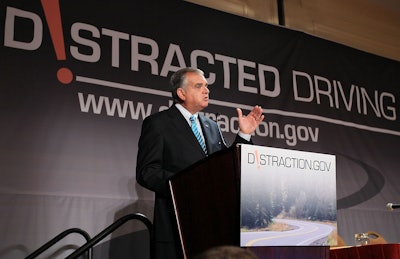
The National Highway Traffic Safety Administration on Thursday, Feb. 16, announced the first-ever federally proposed guidelines to encourage automobile manufacturers to limit the distraction risk for in-vehicle electronic devices. The proposed voluntary guidelines would apply to communications, entertainment, information gathering and navigation devices or functions that are not required to safely operate the vehicle.
The guidelines would establish specific recommended criteria for electronic devices installed in vehicles at the time they are manufactured that require visual or manual operation by drivers. The announcement of the guidelines comes just days after President Obama’s FY 2013 budget request, which includes $330 million over six years for distracted driving programs that increase awareness of the issue and encourage stakeholders to take action.
“Distracted driving is a dangerous and deadly habit on America’s roadways,” said U.S. Transportation Secretary Ray LaHood. “These guidelines are a major step forward in identifying real solutions to tackle the issue of distracted driving for drivers of all ages.”
Geared toward light vehicles – cars, SUVs, pickup trucks, minivans and other vehicles rated at not more than 10,000 pounds gross vehicle weight – the guidelines are the first in a series of guidance documents NHTSA plans to issue to address sources of distraction that require use of the hands and/or diversion of the eyes from the primary task of driving.
In particular, the Phase I proposed guidelines recommend criteria that manufacturers can use to ensure the systems or devices they provide in their vehicles are less likely to distract the driver with tasks not directly relevant to safely operating the vehicle, or cause undue distraction by engaging the driver’s eyes or hands for more than a limited duration while driving. Electronic warning system functions such as forward-collision or lane departure alerts would not be subject to the proposed guidelines, since they are intended to warn a driver of a potential crash and are not considered distracting devices.
“We recognize that vehicle manufacturers want to build vehicles that include the tools and conveniences expected by today’s American drivers,” said NHTSA Administrator David Strickland. “The guidelines we’re proposing would offer real-world guidance to automakers to help them develop electronic devices that provide features consumers want—without disrupting a driver’s attention or sacrificing safety.”
The proposed Phase I distraction guidelines include recommendations to:
Reduce complexity and task length required by the device;
Limit device operation to one hand only;
Limit individual off-road glances required for device operation to no more than two seconds in duration;
Limit unnecessary visual information in the driver’s field of view; and
Limit the amount of manual inputs required for device operation.
The proposed guidelines also would recommend the disabling of the following operations by in-vehicle electronic devices while driving, unless the devices are intended for use by passengers and cannot reasonably be accessed or seen by the driver, or unless the vehicle is stopped and the transmission shift lever is in park.
Visual-manual text messaging;
Visual-manual Internet browsing;
Visual-manual social media browsing;
Visual-manual navigation system destination entry by address;
Visual-manual 10-digit phone dialing; and
Displaying to the driver more than 30 characters of text unrelated to the driving task.
NHTSA also is considering future, Phase II proposed guidelines that might address devices or systems that are not built into the vehicle but are brought into the vehicle and used while driving, including aftermarket and portable personal electronic devices such as navigation systems, smartphones, electronic tablets and pads, and other mobile communications devices. A third set of proposed guidelines (Phase III) may address voice-activated controls to further minimize distraction in factory-installed, aftermarket and portable devices.













